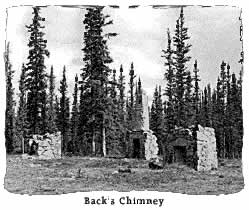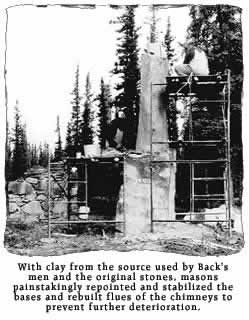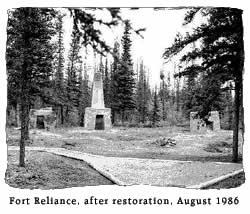|

 The
East Arm of Great Slave Lake is a land of spectacular beauty. Native
people have lived and hunted here for thousands of years. Over the
last two centuries the area, as the entry to the Barrengrounds,
has drawn explorers from other parts of the globe. They, too, have
contributed to the rich history of Great Slave Lake and its environs. The
East Arm of Great Slave Lake is a land of spectacular beauty. Native
people have lived and hunted here for thousands of years. Over the
last two centuries the area, as the entry to the Barrengrounds,
has drawn explorers from other parts of the globe. They, too, have
contributed to the rich history of Great Slave Lake and its environs.
 One of the best preserved sites of early exploration in the western
Subarctic is Old Fort Reliance. It was originally erected in 1833
as winter headquarters for the Arctic Land Expedition, led by George
Back, R.N. His party travelled by way of the Back River (formerly
the Thlew-ee-choh-desseth or Great Fish River) to the Arctic Coast
in an effort to locate the missing John Ross expedition and conduct
scientific studies.
One of the best preserved sites of early exploration in the western
Subarctic is Old Fort Reliance. It was originally erected in 1833
as winter headquarters for the Arctic Land Expedition, led by George
Back, R.N. His party travelled by way of the Back River (formerly
the Thlew-ee-choh-desseth or Great Fish River) to the Arctic Coast
in an effort to locate the missing John Ross expedition and conduct
scientific studies.
A fort in name only, Fort Reliance consisted
of a main house and smaller houses, heated with chimneys constructed
of stone and clay. An observatory for scientific work was also built
here.
- Learn more about Old Fort Reliance's rebirth in 1855
and 1897
Today all that remains are the chimneys, storage
pits, and the outlines of the log buildings in the earth.
 The
Prince of Wales Northern Heritage Centre, in conjunction with Parks
Canada, has studied the site and carried out a programme to stabilize
and preserve the falling chimneys. The
Prince of Wales Northern Heritage Centre, in conjunction with Parks
Canada, has studied the site and carried out a programme to stabilize
and preserve the falling chimneys.
There is still much to be learned from this site. These fragile
remains are protected from disturbance by the Northwest
Territories Archaeological Sites Regulations.
|
 The
East Arm of Great Slave Lake is a land of spectacular beauty. Native
people have lived and hunted here for thousands of years. Over the
last two centuries the area, as the entry to the Barrengrounds,
has drawn explorers from other parts of the globe. They, too, have
contributed to the rich history of Great Slave Lake and its environs.
The
East Arm of Great Slave Lake is a land of spectacular beauty. Native
people have lived and hunted here for thousands of years. Over the
last two centuries the area, as the entry to the Barrengrounds,
has drawn explorers from other parts of the globe. They, too, have
contributed to the rich history of Great Slave Lake and its environs. One of the best preserved sites of early exploration in the western
Subarctic is Old Fort Reliance. It was originally erected in 1833
as winter headquarters for the Arctic Land Expedition, led by George
Back, R.N. His party travelled by way of the Back River (formerly
the Thlew-ee-choh-desseth or Great Fish River) to the Arctic Coast
in an effort to locate the missing John Ross expedition and conduct
scientific studies.
One of the best preserved sites of early exploration in the western
Subarctic is Old Fort Reliance. It was originally erected in 1833
as winter headquarters for the Arctic Land Expedition, led by George
Back, R.N. His party travelled by way of the Back River (formerly
the Thlew-ee-choh-desseth or Great Fish River) to the Arctic Coast
in an effort to locate the missing John Ross expedition and conduct
scientific studies.  The
Prince of Wales Northern Heritage Centre, in conjunction with Parks
Canada, has studied the site and carried out a programme to stabilize
and preserve the falling chimneys.
The
Prince of Wales Northern Heritage Centre, in conjunction with Parks
Canada, has studied the site and carried out a programme to stabilize
and preserve the falling chimneys.